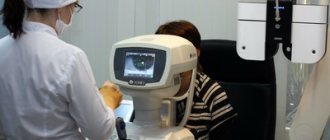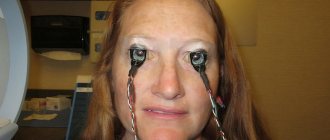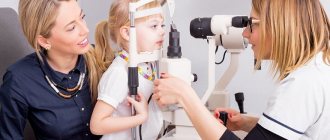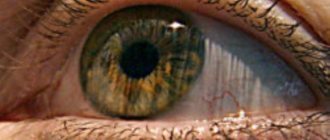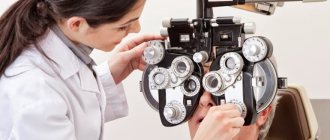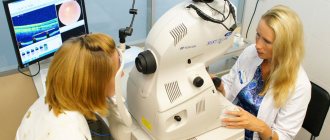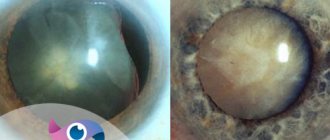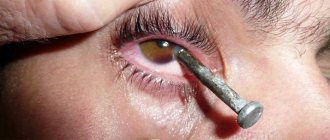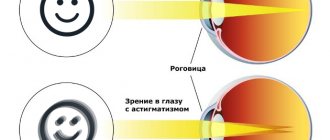EYES – THE MIRROR OF THE SOUL
So the poets will say. And prose writers, for example, will write that the hero “spoke with his eyes alone.” And practical people will notice that a woman, explaining the high price of her next new thing from the shopping center, will certainly emphasize its fantastic color, but this is not surprising. The retina of a woman’s eye is designed in such a way that a woman is actually able to distinguish noticeably more colors and shades than a man! But enough of the lyricism.
Vision is our main sense organ; with the help of vision we receive and “record in memory” almost 90% of the information about the world around us. It is natural, therefore, that the “price” of vision problems, the “price” of eye diseases is ultimately a deterioration in full communication.
It is the ophthalmologists who are responsible for the protection of vision; they are the ones who diagnose and treat eye diseases of their patients in clinics and... and the ophthalmologists of the clinics do the same thing. In fact, these are the same specialists: “oculus” and “ophthalmos” are the same “eye”, only in Latin and Greek.
In what cases should you pay more attention to your vision?
If you currently have a “one” and are not bothered by vision problems, we recommend visiting an ophthalmologist in the following cases:
- With constantly low or high blood pressure, diseases of the cardiovascular system
- When planning a pregnancy
- With a long course of treatment with hormonal drugs
- If you have a hereditary predisposition to glaucoma or cataracts (if your relatives have encountered such a problem)
- If you have had previous injuries or eye surgeries.
Regular visits to your eye doctor are the best gift you can give to your eyes. Take care of your eyesight!
OPHTHALMOLOGIST: WHEN IS A CONSULTATION NEEDED?
Alas, there are many eye diseases that require accurate diagnosis and, often, prompt treatment in a clinical setting. Let's remember only the most “popular”.
Myopia - images of observed objects are focused not on the retina, but in front of the retina: as a result, the patient experiences difficulty in “visually examining” objects located in the distance.
Farsightedness is a disease “the opposite” of myopia. The image is focused behind the retina, and the patient has difficulty distinguishing objects that are located nearby.
Cataract is clouding of the lens. Often caused by age-related changes in the patient's body.
Glaucoma is a pathological condition characterized by increased intraocular pressure. At the initial stage it is asymptomatic, but already requires treatment.
Of course, you should immediately make an appointment with an ophthalmologist and get advice in case of “direct” mechanical or chemical contacts with the eyes: the cost of delay in case of injuries may even be the patient’s complete loss of vision. However, if you contact a medical center in a timely manner, correct diagnosis and correct treatment, many problems can be avoided.
The insidiousness of eye diseases is that often a certain deterioration in vision occurs unnoticed by the patient, while early diagnosis and treatment would have made it possible to maintain vision at the same level. A good solution is to make an appointment with an ophthalmologist once a year at a specialized clinic or medical center, undergo an examination and receive the necessary consultation, and, if necessary, treatment when the disease is still “at the start.”
What is included in the diagnosis
Full diagnostic examination
takes about 2-2.5 hours. It includes:
- accurate determination of the patient's visual acuity and refraction
- intraocular pressure measurement
- examination of the eye under a microscope (biomicroscopy)
- measurement of corneal thickness (pachymetry)
- determination of eye length (echobiometry)
- Ultrasound examination of the eye (B-scan)
- computer keratotopography
- thorough examination of the retina and optic nerve
- determining the level of tear production
- detailed visual field examination
If certain pathologies are identified, the scope of the examination may be expanded.
The examination of the patient begins with a conversation, during which it becomes clear what is bothering him, the duration of the presence of problems in the eye, and the presence of common chronic diseases. Then a hardware determination of the refraction of the eye and non-contact measurement of intraocular pressure are carried out.
Visual acuity testing is carried out traditionally using special tables with letters, pictures or other symbols. The doctor changes the glasses, selecting the most optimal lenses that provide the best vision. Determination of visual acuity is carried out first with a narrow pupil, then in conditions of a wide pupil (after cycloplegia) at the end of the examination. Maximum visual acuity with glasses serves as a prognosis for visual acuity after laser correction.
Examination of the anterior segment of the eye (eyelids, eyelashes, conjunctiva, cornea, iris, lens, etc.) is carried out using a slit lamp. The doctor assesses the condition of the eye structures: the presence of scars, opacities, inflammatory changes, etc.
A full examination includes a visual field test. The study allows us to identify changes in visual fields in a certain pathology. For example, with taperetinal abiotrophy, patients complain of worsening twilight vision. Upon examination, a concentric narrowing of their visual fields is revealed. In some cases, detected changes in visual fields are the basis for consulting a neurologist.
For glaucoma, a special study is performed to determine the depth of damage to the optic nerves.
The most informative method before refractive surgery is considered to be computer topography of the cornea, which gives an idea of the structure of the surface of the cornea, like a geographical map, which makes it possible to exclude or diagnose keratoconus and astigmatism with maximum accuracy; at the same time, the thickness of the cornea (pachymetry) is measured at various points using non-contact and contact methods . These studies make it possible to calculate the maximum permissible depth of laser exposure for high myopia. Based on the data obtained, the question of the possibility of laser correction is being decided.
If necessary, ultrasound determination of the length of the eye (echobiometry), depth of the anterior chamber, and determination of the size of the lens is performed. If there is a cloudy lens (cataract), an intraocular lens is calculated for phacoemulsification surgery.
During a full examination, it is necessary to dilate the pupils with the drugs midriacil, midrum, cyclomed, which makes it possible to determine the static refraction (dynamic, on a narrow pupil is not always reliable). All patients undergo an examination of the fundus of the eye, including the extreme periphery, under conditions of a dilated pupil, to exclude dystrophic changes, subclinical retinal detachments, and hemorrhages.
After a thorough and complete examination, the doctor talks with the patient and, based on all the data, prescribes treatment, talking about possible options.
Fill out an application on the website, we will contact you as soon as possible and answer all your questions.
Make an appointment
HOW IS AN APPOINTMENT WITH AN OPHTHALMOLOGIST?
Of course, in any clinic, an ophthalmologist’s appointment begins with examining the patient’s visual acuity using a table. Further, during the consultation, the doctor, using various tools, conducts studies of other “components” of our visual analyzer, for example, assesses the condition of the retina. Reliable equipment of a modern medical center allows for accurate diagnosis of all diseases. And if urgent surgical intervention is necessary (for example, in case of retinal detachment caused by injury), immediately proceed from the consultation to all measures necessary to preserve the patient’s vision.
So, if you haven't had your vision checked for more than a year, it's time to make an appointment with an ophthalmologist. Is your vision okay? Great, the clinic’s doctors will not only confirm your own “diagnosis” with their research. But they will also tell you how to take care of your eyes so that no vision problems arise in the future.
Ophthalmologists at the Doctor Nearby clinic have all the necessary knowledge, experience and equipment to diagnose and treat eye diseases.
Who needs regular medical examinations with an ophthalmologist?
Patients in the following categories should have their vision checked annually or every six months:
- already having problems and wearing glasses;
- specialists whose work involves prolonged work at the computer;
- pregnant women;
- patients with hypertension and diabetes;
- patients undergoing a long course of hormonal therapy;
- those who have had an eye injury and/or surgery on the eyeball;
- younger schoolchildren and people of older age categories (after 45 years).
During the appointment, an ophthalmologist in Moscow will conduct a diagnosis, the results of which will provide a complete picture of the state of vision, and, if necessary, offer several treatment options.
Diagnostic methods for an ophthalmologist:
In our clinic you can undergo all types of diagnostic examinations for an accurate and quick diagnosis, selection of an effective treatment method or correction of the identified disease:
- Visometry is a study of visual acuity, with correction if necessary. The study is carried out using special tables for testing vision. The resolution of the eye is determined (light sensitivity thresholds, color perception, depth vision)
- Tonometry (measurement of intraocular pressure) according to Maklakov or with an automatic tonometer through the eyelid
- Perimetry - determination of visual fields using a computer perimeter
- Autorefractometry - measurement of the refraction of the eye using optical instruments (refractometers), measurement of the refractive power of the optical system of the eye
- Keratometry - measurement of the curvature of the cornea of the eye
- Fundus ophthalmoscopy is an examination of the fundus of the eye to diagnose retinal diseases, retinal detachment, diseases of the choroid and optic nerve. Performed with a narrow and dilated pupil
- Biomicroscopy of the anterior and posterior segment of the eye is a special method for examining the anterior segment of the eye and fundus using a slit lamp.
- Gonioscopy - examination of the anterior chamber of the eye for glaucoma
- Color vision testing
- Cultures for flora and sensitivity to antibiotics, etc.
Ophthalmologist appointment
During childhood, the visual organs develop very quickly. Such rapid development may be associated with complications and pathologies, which are important to detect in time in order to prescribe effective treatment. A pediatric ophthalmologist (otherwise known as an ophthalmologist) copes with this task.
When is a consultation with a pediatric ophthalmologist necessary?
The first examination of a child by an ophthalmologist is usually carried out in the maternity hospital. If this does not happen, you need to take the child to a consultation yourself within the first month after birth.
At the doctor's appointment:
- will answer all your questions and tell you that screens do not damage your eyesight
- will conduct biomicroscopy of the eye (a non-contact way to study the structures of the organs of vision)
- will check for birth defects and vision pathologies
- examine the fundus of the eye and assess its condition using an ophthalmoscope
- won't give you printouts of eye exercises because they haven't been proven to be effective (he'll instead recommend spending more time outdoors)
Repeated consultations with a pediatric ophthalmologist will be needed in six months and a year. During this period, it is extremely important to undergo an examination, since the child’s eyes are actively developing, refraction is established - anomalies (myopia, farsightedness, astigmatism) can be detected.
The next mandatory visit to a pediatric ophthalmologist is when the child begins to develop binocular vision (the ability to see clearly with both eyes at the same time) and may develop strabismus. This happens around 3 years of age. If refractive error is detected at an early stage, timely and adequate treatment will prevent the development of strabismus in the child.
An examination by an ophthalmologist should be performed once a year for the rest of your life. Many children develop myopia between the ages of 7 and 14; a good pediatric ophthalmologist will create an individual program of therapeutic measures and help reduce the rate of vision deterioration.
The children's clinic of evidence-based medicine DocDeti employs a team of highly qualified pediatric ophthalmologists in Moscow, which has modern technological equipment for the diagnosis and treatment of eye pathologies. In addition, our doctors know that preparations with blueberries will not save you from eye diseases.
What symptoms should you contact a pediatric ophthalmologist for?
It is necessary to make an appointment with a pediatric ophthalmologist in the following cases:
- there is a suspicion that the baby has poor vision (may bring small objects close to his eyes)
- pupils have different diameters
- eyes often water
- a child complains that he is seeing double
- increased sensitivity of the eye to light
- sclera eyes red
- itching and burning in the eyes
- eyelids swell
An immediate visit to a pediatric ophthalmologist is required if the child has sustained an eye injury or a foreign body has entered the eye.
What does a pediatric ophthalmologist treat?
A pediatric ophthalmologist diagnoses and treats many eye diseases, such as:
- inflammatory eye diseases (blepharitis, conjunctivitis, keratitis, etc.)
- abnormalities of the optic nerve
- congenital cataract and glaucoma
- myopia (nearsightedness) and hypermetropia (farsightedness)
- strabismus
- astigmatism
- nystagmus
DocDeti ophthalmologists always act in the interests of their young patients and do not prescribe useless procedures and medications. For example, DocDeti does not use hardware treatment methods in ophthalmology, because their effectiveness has not been proven. We work based on international standards and principles of evidence-based medicine.
If you are looking for a pediatric ophthalmologist in Moscow, contact our clinic. Contact us by phone +7
or fill out the form below - we will select an appointment time convenient for you.
Reasons for urgently visiting an ophthalmologist:
An urgent unscheduled consultation with an ophthalmologist will be required if any discomfort occurs in the eyes or eyelids:
- itching or burning
- irritation and swelling of the eyelids
- redness of the eyes
- pain in the eyes in bright light
- tearfulness
- the appearance of purulent discharge
- feeling of “sand” in the eye
- deterioration of visual acuity, including night vision
- the appearance of “flies”, “stars” or a veil
- the appearance of ulcers, lumps or pigment spots on the skin of the eyelids


